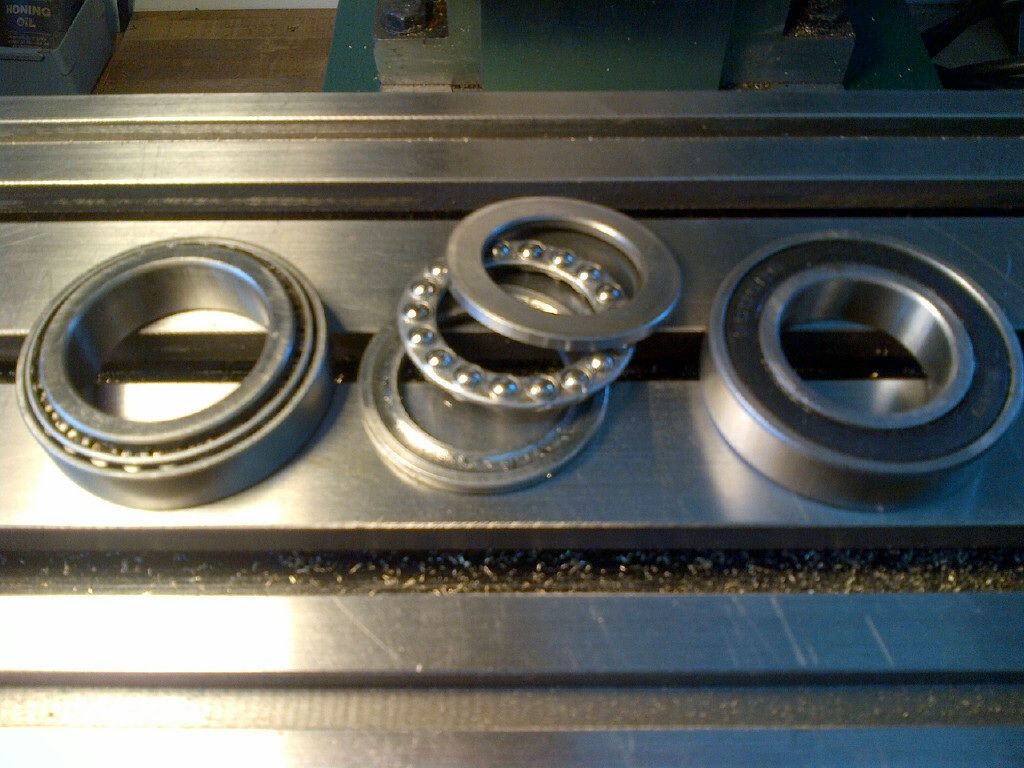Mbusha
Crotchety member
- Joined
- May 4, 2012
- Messages
- 65
- Reaction score
- 13
Just finished putting bearings in my Grizzly SX3 mill spindle. The originals went bad after a short time and did not have a chance as the quill was full of grit. Grizzy sent replacement bearings promptly.
Following the guide I downloaded from the Arc Eurotrade web site, diassembly and bearing replacement was simple enough, except for one point; bearing adjustment (they are silent on this). Searching the forum and Internet produces few hits and differing opinions. Most seem related to industrial (Bridgeport) machines with two tapered bearings. The SX3 has one tapered, one thrust and one roller bearing.
The spindle was cleaned and reassembled with Kluber nub 15. Using a .0001" indicator I adjusted the spanner nuts to just remove any end play. Back in the machine I began the breakin as suggested in the Grizzly manual. 600rpm for ten minutes and everything seemed ok. 1000rpm for an other ten, ok, warm to touch. 1800 and the spindle slowly became noisy and warming too fast. Stopped and it was hard to turn.
Disassembled, cleaned and repeated the process, this time with .0005" end play. the spindle runs ever so slightly warm, after the complete breakin cycle. 10 minutes each a 600, 1000, 1800 rpm and reverse at 1800. the end play and it's .0006".
I actually have a fair amount of experience with machine tools, but only with American made industrial equipment. Home hobby machines are new to me, so I am not so sure what the limits are. The machine as it now sits will, most likely, serve my purpose but as it's a hobby, I don't mind taking it apart for further adjustment. Actually, it comes apart quite easy, and I am getting good at it.
Anyway, sorry for the over long post. Anyone have an opinion? Too tight, too loose?
Following the guide I downloaded from the Arc Eurotrade web site, diassembly and bearing replacement was simple enough, except for one point; bearing adjustment (they are silent on this). Searching the forum and Internet produces few hits and differing opinions. Most seem related to industrial (Bridgeport) machines with two tapered bearings. The SX3 has one tapered, one thrust and one roller bearing.
The spindle was cleaned and reassembled with Kluber nub 15. Using a .0001" indicator I adjusted the spanner nuts to just remove any end play. Back in the machine I began the breakin as suggested in the Grizzly manual. 600rpm for ten minutes and everything seemed ok. 1000rpm for an other ten, ok, warm to touch. 1800 and the spindle slowly became noisy and warming too fast. Stopped and it was hard to turn.
Disassembled, cleaned and repeated the process, this time with .0005" end play. the spindle runs ever so slightly warm, after the complete breakin cycle. 10 minutes each a 600, 1000, 1800 rpm and reverse at 1800. the end play and it's .0006".
I actually have a fair amount of experience with machine tools, but only with American made industrial equipment. Home hobby machines are new to me, so I am not so sure what the limits are. The machine as it now sits will, most likely, serve my purpose but as it's a hobby, I don't mind taking it apart for further adjustment. Actually, it comes apart quite easy, and I am getting good at it.
Anyway, sorry for the over long post. Anyone have an opinion? Too tight, too loose?





